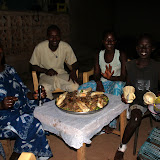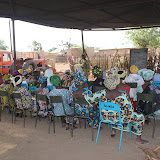The end of 2010 was marked by some very sad news. My host mom, Fanta, did not return with her kids in October for the beginning of school because she was pregnant. She delivered the baby in November, a healthy baby girl, but there were complications following the pregnancy and she passed away a few weeks later.
Death is a difficult subject in any culture. Sadly it is a more common occurrence in Mali than in most parts of the world. The chances for a baby to live past five are shockingly low, and adult life expectancy is only 52 years. But for a mother to pass away, no matter the circumstance, is such a sad event for any family.
My host dad was able to see his wife in Bamako before she died. He chose not to tell the kids before returning to Kenieba a week after Fanta died, so he could tell them in person. I found out the sad news from one of my neighbors, and struggled not to tell my host brother and sister, two of my closest friends here, about their mother’s death. I was basically in denial, only telling my friends and family over the phone. It was a really difficult week, so much so that when my host dad returned to Kenieba, it was practically a relief.
On the night my host father returned, I went over to greet him and meet Fanta’s mother and sister, who came to help console the kids. It was a normal conversation; though I could tell something was wrong, nobody brought up Fanta’s death. I didn’t want to be the one to bring it up; I wasn’t sure how to do so or whether it was the right thing to do. Later that night, people started coming over to give their condolences and blessings.
The next morning, after my host siblings left for school, I came over to the house and my host dad broke the news to me. I gave as many Bambara blessings as I could remember, like may God have pity on the deceased and may her resting place be peaceful. We talked about Fanta, how much I enjoyed her cooking. I left as more people came over to give their condolences. Occasionally I would hear people bawling and just felt helpless. It was a tough morning.
Fanta’s sister brought her two year old daughter, Hawa, with her as well. Having Hawa around certainly lightened the mood. It was an interesting parallel, as there were also infants around when my grandmother passed away a few years ago. It’s amazing how certain things like the circle of life transcend cultures, mourning a family member's death while recognizing that these infants have their whole lives ahead of them.
For two days, the family fasted during the day in honor of Fanta’s death and to affirm their Muslim faith. It was a somber week. My host family is really special; they have three smart and polite kids, which I can’t say about most Malian families. To have their mother taken from them so suddenly is heartbreaking.
I feel the most sad for Tenin and Zakariyah, my host siblings. Though they are 16 and 12, they are still just kids with promising futures ahead of them. The oldest daughter is in high school in Bamako, and presumably Tenin and Zakariyah will follow her path and gain a good education. My host brother didn't want to tell anyone, not even his teachers, that his mom died. He had school exams coming up that same week, and he was worried that if more people knew, they would continue to remind him of his mother’s death. Though I protested when I heard that, my host dad said that it’s a private matter and his personal decision. Also, my host dad told me that the newborn baby will be brought up by his brother and his brother's wife in Bamako.
Fanta’s mother and sister stayed for about ten days, and Tenin and Zakariyah left with them to spend the school vacation with family in Bamako. It was nice to get to know Fanta’s mother and sister towards the end of their time here. We got to travel on the same bus together, as I left for the Christmas holiday at the same time. Hawa was really afraid of me when she first arrived, but warmed up to me and would even come and sit on my lap by the end. It was an uplifting ending to a very difficult time.
(taken November 2009)





















